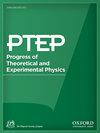T-Minkowski 非交换时空 I:庞加莱群、微分计算和编织
IF 8.3
4区 物理与天体物理
Q1 Physics and Astronomy
引用次数: 0
摘要
本文介绍并研究了一类非交换时空,我称之为 "T-Minkowski",其量子 Poincaré 群的等距表现出独特的物理特征。值得注意的是,洛伦兹子群上的坐标仍然是交换的,而变形仅限于平移(因此名称中出现了 "T"),平移就像洛伦兹群上可积分的矢量场集合。这与马吉德的二交积构造类似,不过我的方法允许描述换元包含常数矩阵以及坐标线性项的时空(由此产生的结构是中心扩展的李代数)。此外,我要求可以定义量子波恩卡莱群的协变张量乘表示,描述 N 点代数。这也意味着在非交换时空中存在一个 4 维双变量微积分。由此产生的模型都可以通过 RTT 关系(以及 RXX、RXY 和 RXdX 关系来描述均相时空、编织和微分计算)用数值三角 R 矩阵来描述。我发现的 R 矩阵与波恩卡莱群上的三角 R 矩阵一一对应,洛伦兹生成器中没有二次项。扎克泽夫斯基(Zakrzewski)已经对这些模型进行了分类(直到自动形态),共分为 16 个不等价模型。本文是系列论文的第一篇,重点是识别我的假设所允许的所有量子波因卡雷群,以及相关的量子同质时空、微分计算和编织构造。本文章由计算机程序翻译,如有差异,请以英文原文为准。
T-Minkowski noncommutative spacetimes I: Poincaré groups, differential calculi and braiding
This paper introduces and investigates a class of noncommutative spacetimes that I will call “T-Minkowski,” whose quantum Poincaré group of isometries exhibits unique and physically motivated characteristics. Notably, the coordinates on the Lorentz subgroup remain commutative, while the deformation is confined to the translations (hence the T in the name), which act like an integrable set of vector fields on the Lorentz group. This is similar to Majid’s bicrossproduct construction, although my approach allows the description of spacetimes with commutators that include a constant matrix as well as terms that are linear in the coordinates (the resulting structure is that of a centrally-extended Lie algebra). Moreover, I require that one can define a covariant braided tensor product representation of the quantum Poincaré group, describing the algebra of N-points. This also implies that a 4-dimensional bicovariant differential calculus exists on the noncommutative spacetime. The resulting models can all be described in terms of a numerical triangular R-matrix through RTT relations (as well as RXX, RXY and RXdX relations for the homogeneous spacetime, the braiding and the differential calculus). The R-matrices I find are in one-to-one correspondence with the triangular r-matrices on the Poincaré group without quadratic terms in the Lorentz generators. These have been classified, up to automorphisms, by Zakrzewski, and amount to 16 inequivalent models. This paper is the first of a series, focusing on the identification of all the quantum Poincaré groups that are allowed by my assumptions, as well as the associated quantum homogeneous spacetimes, differential calculi and braiding constructions.
求助全文
通过发布文献求助,成功后即可免费获取论文全文。
去求助
来源期刊

Progress of Theoretical and Experimental Physics
PHYSICS, MULTIDISCIPLINARY-PHYSICS, PARTICLES & FIELDS
CiteScore
12.00
自引率
5.70%
发文量
148
审稿时长
17 weeks
期刊介绍:
Progress of Theoretical and Experimental Physics (PTEP) is an international journal that publishes articles on theoretical and experimental physics. PTEP is a fully open access, online-only journal published by the Physical Society of Japan.
PTEP is the successor to Progress of Theoretical Physics (PTP), which terminated in December 2012 and merged into PTEP in January 2013.
PTP was founded in 1946 by Hideki Yukawa, the first Japanese Nobel Laureate. PTEP, the successor journal to PTP, has a broader scope than that of PTP covering both theoretical and experimental physics.
PTEP mainly covers areas including particles and fields, nuclear physics, astrophysics and cosmology, beam physics and instrumentation, and general and mathematical physics.
 求助内容:
求助内容: 应助结果提醒方式:
应助结果提醒方式:


